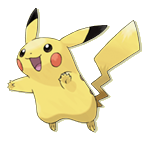|
|
GBC_Pokémon_Yellow.PNG
Pokémon Yellow: Special Pikachu Edition is the fourth game in the Pokémon video game series in Japan and the third game in the series in North America. It was released on the Nintendo Game Boy and follows Pokémon Red, Pokémon Blue, and Pocket Monsters: Green. It is impossible to get any Yellow version Pokémon to the Ruby, Sapphire, Emerald, FireRed or LeafGreen versions.
The game was released in Japan on September 12, 1998 and was simply known as Pocket Monsters Pikachu. It was released in North America on October 1, 1999 and was called Pokémon Yellow Version: Special Pikachu Edition by Nintendo.
In both regions, the games are often referred to by fans as simply Pokémon Yellow or Pokémon Pikachu.
The name (and Pikachu on the cover) is due to the fact that Trainers get Pikachu as their starter Pokémon (like Ash Ketchum did) instead of being able to choose between Bulbasaur, Charmander, and Squirtle.
Pokémon Yellow was originally designed to be tradeable with the Red and Blue versions, though players can trade with it to Pokémon Gold, Pokémon Silver, and Pokémon Crystal. However, any of the 100 Pokémon introduced in those versions cannot be traded into Yellow, just like they can't be traded into the Red or Blue versions.
The graphics are considered by most to be an improvement over the original Red and Blue games'. Yellow was colorized to a limited extent – for example, the Pokémon's art is colored a single color for each Pokémon, and each city shades everything in its particular tint.
Pokémon Yellow can be played any of the handheld Game Boy units, as well as the Super Game Boy and the Game Boy Player. On the Nintendo 64, Pokémon Yellow could be played on the television through Pokémon Stadium and Pokémon Stadium 2 with the use of Nintendo 64 Transfer Pack.
Both Pokémon Stadium games offer support Pokémon Yellow, allowing for the Pokémon in the game to be uploaded into the Nintendo 64 for three-dimensional battles and new features. Using the Yellow Pikachu in the Stadium games makes it sound like Pikachu from the Pokémon anime.
Pokémon Yellow was followed by Pokémon Gold and Pokémon Silver for the Game Boy Color.
Game information
Pokémon Yellow was not one of the original Pokémon releases, but a new version based upon the very popular Pokémon anime. In this game, like in the cartoon, the main character was given a Pikachu instead of given a choice between the three starter Pokémon from Red and Blue.
This made the game a bit harder at the beginning than the previous two games, since Pikachu's electric attacks are ineffective against the first Gym Leader. Several Pokémon had their move lists altered, giving them different attacks, allowing them to access some of their more powerful attacks earlier, or allowing them to learn from new Technical Machines.
Like in the cartoon, Team Rocket members Jessie and James make their appearances along with their Pokémon, although they are never named as such in the game. They always attack with the same Pokémon – Ekans (which evolves into Arbok later in the game), Koffing (which evolves into Weezing later in the game) and Meowth.
As for the original three starters, Bulbasaur, Charmander, and Squirtle, Pokémon Yellow allows the player the chance to acquire those three Pokémon without having to trade for them from Red or Blue.
The game also had smaller changes to closer reflect the anime's first season. The receptionist in each Pokemon Center is now Nurse Joy, and many of the Trainers the player meets have their Pokemon lineups and dialogue altered to represent characters Ash met in the anime. Many of the Gym Leaders also had similar alterations as well.
Yellow's Pikachu
Pokémon_Yellow_Title_Screen.png
Pokémon Yellow Title Screen
In Red, Blue, and Green, Pikachu was just a normal creature that could be captured in Viridian Forest or the Power Plant. This time, however, a Pikachu is given to the player at the beginning of the game. The player's rival gets an Eevee which the professor had been saving. There are no other catchable Pikachu in the game, and the player does not get to choose their starter as in most games in the series.
This Pikachu is modeled off the one in the anime. Therefore it hates Pokéballs, so remains outside of its Pokéball for most of the game.
When the player entered certain buildings and rooms, the Pikachu would react in some way. It was generally easy to tell its mood by examining it. The player could face Pikachu and "talk" to it, like everything else in the game world, by pressing A. A box would appear showing Pikachu's face, and it would say its name "Pikachu!" with various inflections. This, along with its facial expression, told the player about Pikachu's current mood.
Also, as in the anime, it refuses to evolve with a Thunderstone. Therefore the player cannot get a Raichu in this game without trading or cheat devices.
Pokémon information
There are a grand total of 151 Pokémon programmed into Pokémon Yellow. However, there are normally only 137 total Pokémon that can be found in Yellow alone. For 13 of the missing Pokémon, one would have to trade with Blue and Red.
These 13 Pokémon are:
The 14th missing Pokémon is Mew, which is normally unobtainable unless the player receives one from Nintendo. Note that in actuality, in Yellow alone it is possible to obtain all 151 Pokémon, including Mew, by exploiting the "Mew glitch". [1] (http://www.gamefaqs.com/portable/gameboy/game/23705.html) (see Glitch Guide) by Imakuni.
Although the Cinnabar coast glitch--through which Missingno. could be obtained--was removed from the Yellow version, Glitch City was not removed, and can be accessed in the same way as in the Red and Blue versions, except that the actual city will be totally different. (Note also that Missingno. can still be caught using the "Mew glitch". Additionally, trading the Pokémon 'M into the Yellow version results in another glitch Pokémon called 3TrainerPoké.)


